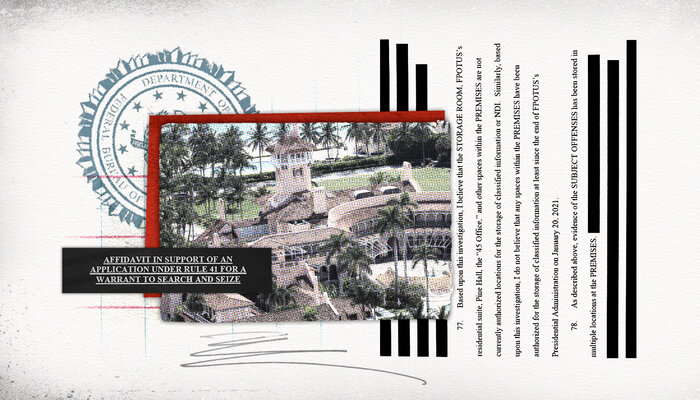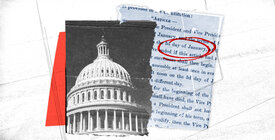Among the government documents that former president Donald Trump improperly retained at Mar-a-Lago were more than 300 documents that bore unambiguous classification markings. Not only should these documents have been turned over to the National Archives and Records Administration (in accordance with the Presidential Records Act), but their storage at an insecure location violated the rules governing the handling of classified material — and could have put national security at risk. Trump has defended his conduct by claiming, without any evidence, that he declassified the documents.
These developments raise key questions about how classification and declassification work, the rules governing the system, whether the president must adhere to those rules, and how all of this could affect the legal issues in this case.
What information can be classified, and by whom?
Under a system established by presidential executive order in 2009, the president, vice president, and agency heads may designate other executive branch officials to serve as original classification authorities. These officials may classify government information if they determine that its disclosure would harm national security. There are three levels of classification, depending on the severity of the anticipated harm to national security: Confidential, Secret, and Top Secret. Within the Secret and Top Secret categories, certain information derived from intelligence sources, methods, or analytical processes may be further classified as Sensitive Compartmented Information.
In addition to this system, Congress has established a parallel system dating back to the 1950s for control of certain nuclear information. Any information regarding the design, manufacture, or utilization of atomic weapons; the production of special nuclear material; or the use of special nuclear material in the production of energy must be designated as Restricted Data. This process is overseen by the Department of Energy.
What are classification markings, and why are they important?
The entire reason for the classification system is to ensure protection of classified information. Such protections can only be implemented if officials who handle the information know that it’s classified. The process of classification therefore involves two steps: determining that the information requires protection and flagging the information to ensure that it is protected.
The government has two main ways of accomplishing this second step.
The first is a system of markings. All classified information in a document must be clearly marked so that anyone who handles that document knows exactly what protections are required. Markings must include, among other information, the level of classification — e.g., Confidential, Secret, Top Secret, Top Secret/Sensitive Compartmented Information, Restricted Data, Formerly Restricted Data.
Second, agencies maintain classification guides that specify categories of information that have been deemed classified by original classification authorities (for instance, “names of covert operatives”). These guides can run hundreds of pages long, and there are thousands of them throughout the federal government.
How is classified information protected?
A range of protections is in place to guard against the disclosure of classified information. Only those government employees and contractors with the requisite security clearance may have access to classified documents, and even then, only if they have a “need to know.” Some documents that are classified as Top Secret/Secure Compartmented Information might be accessible only to a handful of executive branch officials. Classified documents also must be transmitted through, and stored on, secure systems or facilities. Officials who mishandle classified documents or disclose them without authorization are subject to administrative or even criminal penalties.
Information designated as Restricted Data is subject to separate and more stringent protections than other types of classified information. However, if the Department of Energy and Department of Defense jointly determine that data regarding the military use of nuclear weapons can adequately be protected through the normal classification system, they may redesignate that data as Formerly Restricted Data. The data must still be protected, but it is treated like other types of classified information rather than Restricted Data.
How does declassification work?
Information is usually declassified through a process known as “automatic declassification” (which is, in practice, anything but automatic) that takes place after information has been classified for 25 years. However, information may be declassified sooner if it is marked with an earlier declassification date; if the original classification authority who classified the information, their successor or supervisor, or another designated official determines that it no longer meets the standards for classification; or if the agency head or a designated senior agency official determines that the public interest in disclosure outweighs the need for protection. The decision to declassify is made in consultation with all agencies that have an interest in the information.
Information designated as Restricted Data or Formerly Restricted Data is subject to separate rules. By statute, Restricted Data may only be declassified by authorized Department of Energy officials. Although the statute is less clear on this point, it has consistently been interpreted to give the Departments of Energy and Defense sole authority to declassify Formerly Restricted Data, an interpretation enshrined in agency regulations. Neither category is eligible for “automatic” declassification.
As with classification, declassification is a two-step process. First, an authorized official must determine that the information no longer requires protection. Second, that determination must be communicated so that the protections are removed. Accordingly, when a decision has been made to declassify information, it must be marked as declassified. If the declassification affects an entire category of information, the agency’s classification guide must be updated accordingly. If it is narrower, the decision may be captured in a declassification guide — although often, the consultation process that accompanies a declassification decision is sufficient to alert the necessary personnel.
Where are all these rules set out?
For the most part, the rules for classification and declassification are set forth in presidential executive orders, along with regulations issued by the Information Security Oversight Office — an office within the National Archives and Records Administration — implementing those orders. Most presidents, dating back to the beginning of the modern classification system in the 1940s, have issued their own executive orders on classification. Trump was an exception, issuing no order on this subject. President Biden has not yet issued an executive order on classification (although there are reports that one is underway), so the order currently in place is the one issued by President Obama in 2009.
As noted, though, there are separate rules for the classification and declassification of nuclear information. These rules are established in the Atomic Energy Act and implementing regulations issued by the Department of Energy.
Does the president have the authority to declassify information?
Yes and no.
In most cases, classification and declassification are exercises of the president’s authority under Article II of the Constitution to safeguard national security information. Through executive order, the president has delegated that authority to other members of the executive branch (original classification authorities, the Information Security Oversight Office, etc.), but it is fundamentally a presidential power that the president may personally exercise.
There are exceptions, however. The Constitution also provides Congress with significant authority in the area of national security. In areas where the president and Congress share power, Congress may choose to legislate in ways that limit the president’s authority. For example, because Congress has specified that only the Department of Energy may declassify certain nuclear information, the president has no authority to do so.
Notably, some of the documents the FBI retrieved from Mar-a-Lago had Formerly Restricted Data classification markings on them. Formerly Restricted Data can include information about the nuclear stockpile size, current and past locations of nuclear weapons, weapons yield information (i.e., how powerful they are), and above- or below-ground test results. Under long-standing interpretations of the Atomic Energy Act, such information may be declassified only by the Departments of Energy and Defense.
Moreover, it is important to understand the nature of the president’s constitutional authority in this context. Under Article II, the president is responsible for making judgments about national security harm. If a president determines that protections for classified information can be removed without harming national security or that the public interest in disclosure outweighs any such harm, he has exercised that judgment. If, on the other hand, a president alters a document’s classification status for some other reason — for instance, it would be more convenient for him to work at home than in a secure facility, or he simply failed to apply the required protections — such an action is arguably an abdication of his Article II responsibility rather than an exercise of it.
Can the president declassify information without following the rules?
That depends on who you ask.
The rules for declassification are set forth in a presidential executive order and implementing regulations. These rules have the force of law, which means they are binding on all who classify or declassify information. Of course, a president who wishes to alter their terms has a ready means to do so: he can simply revoke or revise the order. In that sense, a president is not truly “bound” by an executive order. While that order remains in force, however, respect for the rule of law suggests that he must abide by it.
The government has taken a different view. During the administration of President George W. Bush, the Department of Justice issued a secret legal memorandum opining that presidents need not adhere to executive orders and that if they do not comply with an executive order, they have simply “waived” or “modified” it through their actions. Moreover, according to the memorandum, the public need not be notified of the waiver/modification. When the gist of the memorandum became public — thanks to the efforts of Sen. Sheldon Whitehouse (D-RI) — it came under heavy criticism, but there is no public indication that it has been withdrawn.
One thing the president cannot do, though, is declassify information “by thinking about it” — i.e., without communicating that decision to anyone else. This conclusion follows not from any particular legal requirements but rather from the very essence of what it means to classify or declassify information. As noted above, these are two-step processes: first, an official determines whether the information requires protection, and second, the information is flagged to ensure that the protections are applied or removed. If an official claims to have classified or declassified information after taking the first step but not the second, it’s like a customer saying she ordered food at a restaurant when she has decided what she wants to eat but hasn’t told the waiter.
Why does it matter whether Trump actually declassified the documents in question?
It doesn’t! The legal issue currently before the courts is whether Department of Justice officials can be barred from reviewing the seized documents and using them in their criminal investigation until a special master can determine whether some of them are Trump’s private papers that must be returned to him. The district court judge issued such a prohibition, but a three-judge panel (including two Trump appointees) of the 11th Circuit Court of Appeals stayed her ruling as it applied to 100 documents with classification markings. As the appeals court recognized, the executive order allows original classification authorities to classify information only if it “is owned by, produced by or for, or is under the control of the United States Government.” By definition, that is government information — not private papers. Subsequent declassification does not change the information’s origins.
Nor does the classification status of the documents affect Trump’s criminal liability. The Department of Justice has publicly cited three criminal statutes that might apply in this investigation. None of them require that the information be classified. The most serious charge, the Espionage Act, criminalizes mishandling of information “relating to the national defense.” Generally, judges consider classification to be strong evidence that information relates to the national defense. But unclassified or declassified information can still qualify — particularly when the declassification happened entirely outside the usual process, involving no consultation with the relevant agencies about the national security implications of removing protections.







